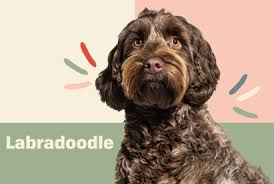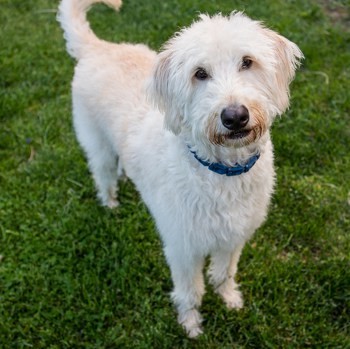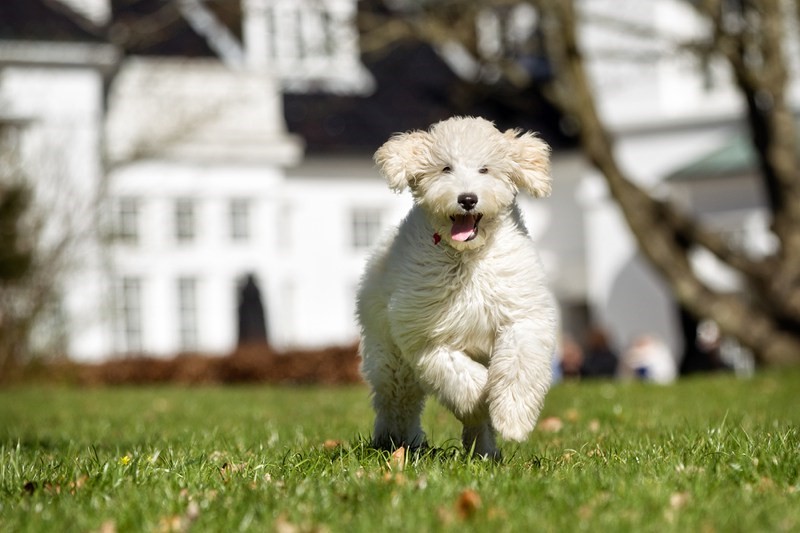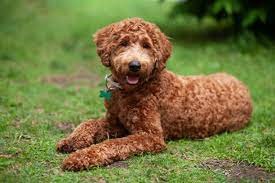
Labradoodle


Labradoodles are designer dogs resulting from the crossbreeding of a Labrador Retriever and a Poodle. Initially designed to serve as hypoallergenic guide dogs, Labradoodles soon became popular for their gentleness and joyfulness. Labradoodles are high-energy dogs that combine the personality traits of both Poodles and Labradors.
Because the Labradoodle is not a breed, there is no consistency in terms of appearance or temperament. Size, coat colour, and character vary a lot and they may be prone to the same diseases their parents are. Regardless, they make wonderful family dogs and are also used as guide, assistance, and therapy dogs.
About & History
The Labradoodle was created by an Australian breeder and veterinarian named Wally Conron at the Royal Guide Dogs Association of Australia in Victoria. Though they first appeared in 1955, it was not until 1988 that these designer dogs became popular. By crossbreeding a Labrador Retriever and a Poodle, Conron aimed at combining the low-shedding properties associated with the Poodle with the overall friendliness and trainability of the Labrador Retriever. This crossbreeding would hopefully result in a hypoallergenic dog that could be used as a guide dog for people with allergies.
Though not entirely successful, as Labradoodles are not hypoallergenic, some shed less. However, because the Labradoodle is not a dog breed, there is much inconsistency across dogs with some characteristics, such as shedding potential, being unpredictable until the animal reaches adulthood.
Born from Conron’s first litter, Sultan served as a guide dog in Hawaii for 10 years. Today, many organisations that breed guide and assistance dogs train Labradoodles. Jonnie was the first guide dog graduating from the Association for the Blind of Western Australia in 2010. However, and despite many became successful guide and assistance dogs, Conron has stated he regretted creating the crossbreed in the first place. The inconsistency of Labradoodles’ characteristics created problems, especially with the rise in popularity that was observed in the past years.
Some breeders only cross purebred Labrador Retrievers and Poodles, creating an F1 hybrid generation that is more genetically uniform, more diverse, and thus has less inherited health issues. Other breeders, on the other hand, cross Labradoodles with other Labradoodles, creating F2 hybrids that may be prone to more problems due to the limited gene pool size. These are also called multigenerational or Australian Labradoodles. Some lines even include crosses with English or American Cockers, Irish Water Spaniels, and Soft-Coated Wheaten Terriers.
Fanciers of this designer breed and groups involved in breeding Labradoodles have been making efforts to achieve a breed status, with the objective of bringing breeders together to standardise breeding criteria. Besides guide and assistance dogs, Labradoodles can make great therapy dogs and, of course, family pets.
You'll also find hybrids of this hybrid with breeders now crossing the Labradoodle with the Goldendoodle to create what they call the Double Doodle!
Appearance

Labradoodles may have three different types of hair: straight (called hair), wavy (fleece), or curly (wool). The type of hair is unpredictable, and coats may vary from a bit wirier to soft. Though they may come in all colours, the most common coat colours are:
Chocolate Brown
Cream
Apricot
Red
Black
Silver
Chalk
There are three possible sizes: the standard Labradoodle is between 53 and 61 cm tall (21-24 inches) and weighs from 23 to 27 kg (50-60 lb); the medium Labradoodle that is 43 to 51 cm tall (17-20 inches) and weighs 14 to 20 kg (30-45 lb); and the average Labradoodle, 36 to 41 cm tall, weighing 7 to 11 kg (15-25 lb).
Character & Temperament
Labradoodles are smart and sociable dogs, affectionate with both adults and children, and pets. They are friendly, energetic, very intelligent, and always ready to play. They love water and they are good swimmers, just like their parents. Being versatile family and therapy dogs, Labradoodles are devoted and enthusiastic, with an eagerness to please that makes training quite easy. People usually say Labradoodles have the energy of a Labrador and the work ethics of both Labradors and Poodles.
The Labradoodle is considered a good pet for those having a dog for the first time, as they are generally easy-going and can be calm, despite all their energy and playfulness. Again, because this is not a breed, there is a lack of consistency in their offspring, with some puppies being smarter, more reserved, and quiet like Poodles, and others being noisier and slower to mature, like Labradors. The same goes with their coat, as it can either be of a more high-maintenance type or shorter, as well as prone to shed.
Labradoodles are generally high-energy dogs that are not well suited to live in an apartment and need physical and mental stimulation to thrive as healthy dogs. Exuberant jumpers, Labradoodles can be too much for small children, accidentally knocking them down. The Labradoodle is a gentle dog with not many guard dog features, though it will probably bark to alert that visitors are coming.
Trainability

Eager to please, Labradoodles are easy dogs to train. Like all other dogs, consistency and repetition are a must and a firm, but gentle hand is required. Dogs need rules and benefit from schedules and training sessions.
Training sessions should be performed daily and kept short. These will help establish a human-dog bond that is extremely important for both owner and pet. Socialisation and exposure to different animals, people, and places are also paramount for Labradoodles to grow as stable and well-rounded dogs.
Health
Labradoodles may live up to 14 years, but are prone to some diseases, usually common in Labrador Retrievers and/or Poodles:
Hip Dysplasia
Following their parents’ disposition for hip dysplasia, Labradoodles are also prone to this orthopaedic condition that causes pain, lameness, and movement impairment. Hip dysplasia is the consequence of an abnormally formed hip joint that leads to an improper fitting of the thighbone onto the hip socket, causing inflammation and degeneration of the joint. Diagnosis is usually attained by X-rays and scoring tests, and treatment may be surgical or therapeutic (with drugs that help alleviating the symptoms).
Eye Diseases
Labradoodles may suffer from different eye conditions that include progressive retinal atrophy, multifocal retinal dystrophy, and cataracts. These are all hereditary conditions that cause sight impairment and owners usually notice the first symptoms when their dogs start bumping into furniture, walls or other objects because they cannot see well.
Elbow Dysplasia
Elbow dysplasia is the correspondent of hip dysplasia, only occurring in the elbow joint. When bones do not fit correctly due to a malformation, there is distress in the articulation that becomes inflamed and swollen. Consequently, dogs experience pain and may refuse to walk or climb stairs or become lame.
Hypothyroidism
Hypothyroidism is a metabolic disease resulting from a deficiency in thyroxine production, a hormone produced by the thyroid gland that regulates metabolism. Symptoms of hypothyroidism include weight gain, lethargy, muscle loss, and alopecia (hair loss). Hormone replacement is the standard treatment that usually works well when there is owner compliance.
Addison’s Disease
Also called hypoadrenocorticism, Addison’s disease is a health issue resulting from a decreased secretion of corticosteroids by the adrenal glands (located near the kidneys). Corticosteroids are hormones that help maintaining the normal metabolism of the body.
Addison’s disease may be difficult to diagnose because clinical signs are usually vague, including lethargy, vomiting, anorexia, and muscle weakness. The disease is treated by hormone replacement.
Exercise and Activity Levels
Labradoodles are high-energy dogs that need at least half an hour of exercise each day. An hour a day is ideal, as bored dogs that are not exercised enough may turn into destructive dogs that are hard to handle. Games and brain exercises are great ways of bonding and keeping Labradoodles entertained and challenged, both mentally and physically.
Grooming
Labradoodles were meant to be low-shedding, hypoallergenic dogs. Though some are less prone to shed and are less allergenic than the average dog, others are not. They are considered to have less “doggy odour” than their Labrador parents. One to two brushings per week, depending on which type of coat it has, will keep the Labrador’s hair and coat looking good. Ear cleaning and nail clipping, when necessary, are also grooming tasks that need to be done regularly.

Credit Dr Ana Oliveira (DVM, University of Lisbon) DogZone.com